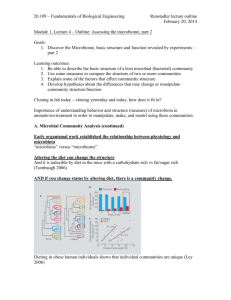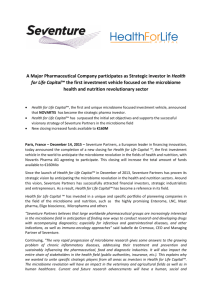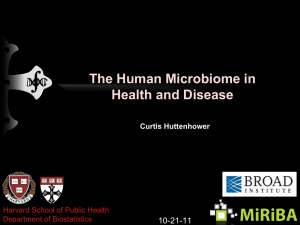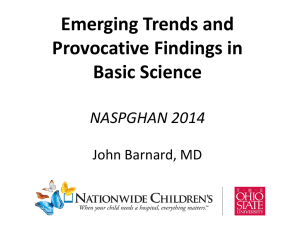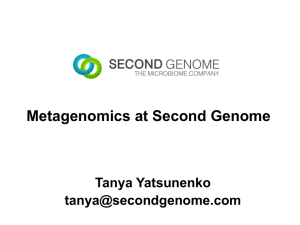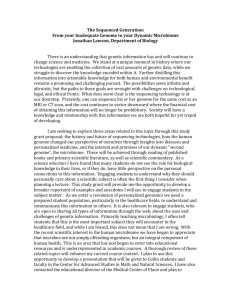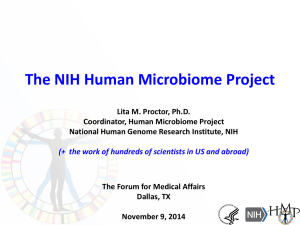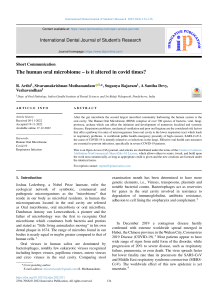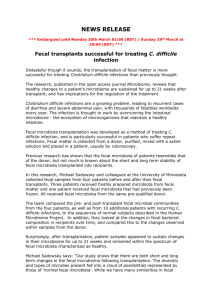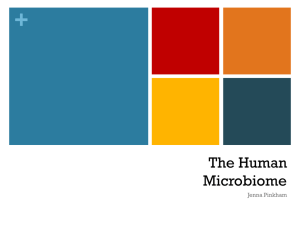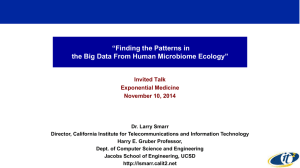Clostridium difficile
advertisement
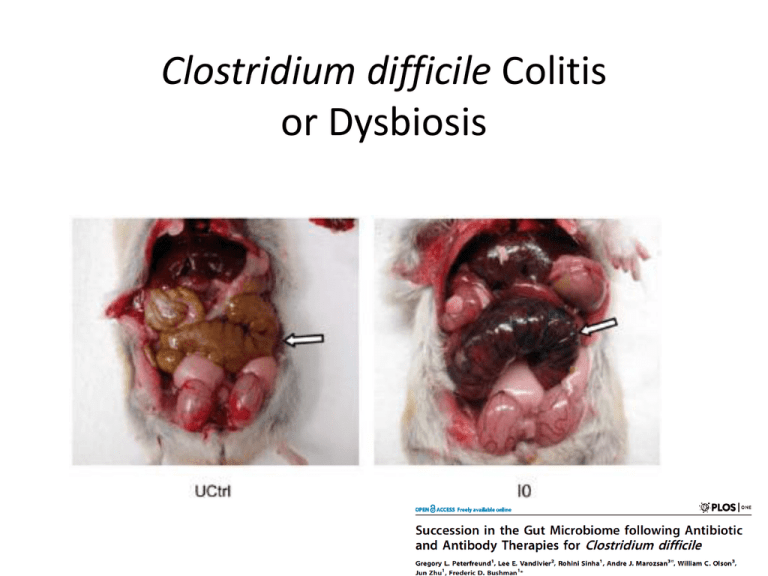
Clostridium difficile Colitis or Dysbiosis Symbiostasis/Dysbiosis Overview • The human microbiome and how one studies it • Effect of antibiotic on microbiome • Clostridium difficile colitis • Changes in the microbiome • Fecal transplants as a treatment option Aspects of the Microbiome to Consider: • • • • • • • Amount Richness (how many taxa) Diversity (how many taxa and how even) Evenness (how even the distribution of taxa) Specific organisms presence / abundance Specific genes presence / abundance Expression profiles Complexity of Human Gut Microbiota • Eckburg et al, 2005. Science. • At least 500 species are present in human intestine. • Each subject had a “distinct” microbiota. • Red = Gram-positives • Yellow = Gram-negative anaerobes • Blue = “Enteric” Bacteria Complexity of Human Gut Microbiota • Eckburg et al, 2005. Science. • At least 500 species are present in human intestine. • Each subject had a “distinct” microbiota. • Red = Gram-positives • Yellow = Gram-negative anaerobes • Blue = “Enteric” Bacteria How many Bacterial Phyla? How diverse are the Microbes? Alpha-Diversity Diversity within a sample • Shannon’s diversity index – H proportion of individual species to all species – S total number of species (richness) – EH equitability (H'/ln(S), evenness, 0 to 1, 1 = even) • ACE: richness based on estimation of sample coverage • Simpson’s – D diversity index – S total number of species (richness) – EH equitability (D/S, evenness, 0 to 1, 1 = even) Diversity and Evenness 1 species accounts for 90%, the other 10% are evenly distributed Shannon’s diversity index H proportion of individual species to all species EH equitability (evenness, 0 to 1, 1 = even) Simpson’s D diversity index EH equitability (evenness, 0 to 1, 1 = even) http://www.tiem.utk.edu/~gross/bioed/bealsmodules/simpsonDI.html Characterization of Microbiomes DNA Isolation from Microbial Community within Mouse Small Intestine PCR Amplification of the V4 Hypervariable Region of the 16S rRNA Gene Illumina MiSeq Amplicon Sequencing Illumina.com Illumina.com Microbial Composition Analyses 16S rRNA Gene Aids in Microbial Community Profiling V4 V6 V7 V5 V3 V8 V1 V2 V9 UCSC.edu Bioinformatics-toolkit.org Complexity of Human Gut Microbiota • Eckburg et al, 2005. Science. • At least 500 species are present in human intestine. • Each subject had a “distinct” microbiota. • Red = Gram-positives • Yellow = Gram-negative anaerobes • Blue = “Enteric” Bacteria Beta-Diversity of Samples The diversity between samples • Bray Curtis, an OTU abundance-based metric • Ochiai, an OTU presence/absence-based metric • Unweighted Unifrac, phylogenetic-based metric • Weighted Unifrac, abundance and phylogenetic-based metric Another way to Depict the Data: PCoA • Principle Coordinates Analysis (different from a PCA or Principle Component Analysis) • The distance matrix data from UniFrac is used • Look for the % on each axis to see how much of the total distance is explained by each axis Residents vs Tourists Effect of Antibiotic Treatment on Fecal Microbiome Heat map displaying the relative abundance of refOTUs in three prominent clades of bacteria. Dethlefsen L , Relman D A PNAS 2011;108:4554-4561 ©2011 by National Academy of Sciences PCoA of unweighted UniFrac distances, a phylogenetically aware measure of intersample (β) diversity. Dethlefsen L , Relman D A PNAS 2011;108:4554-4561 ©2011 by National Academy of Sciences PCoA of unweighted UniFrac distances, a phylogenetically aware measure of intersample (β) diversity. Dethlefsen L , Relman D A PNAS 2011;108:4554-4561 ©2011 by National Academy of Sciences C. difficile toxins: Enterotoxin (toxin A): produces chemotaxis, hemorrhagic necrosis Cytotoxin (toxin B): depolymerization of actin Culture-Based Study • Microbes were cultured from fecal samples, identified and quantitated Clostridium difficile associated diarrhea Hamster Animal Model • Disease is induced/treated • Microbiome monitored In hamsters Toxin antibody treatment protects After 40 days qPCR of C. difficile 16S rRNA Change in Bacteroidales composition Human Fecal Transplant Trial • Microbiome monitored before and after transplant Conclusions • The microbiome is very complex and when disturbed lead to dysbiosis. • C. difficile infected patients have a large scale change in the microbiome, some microbes that are thought to be antagonistic to C. difficile disappeared. • Fecal transplants benefit patients immediately, even before the microbiome rebounds to a normal state.
